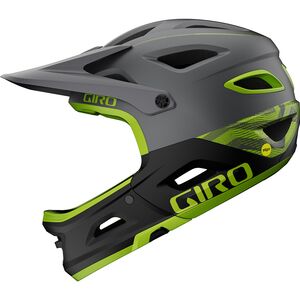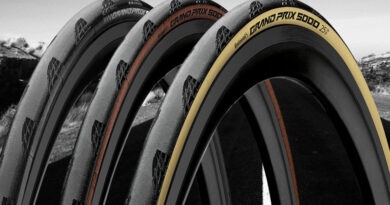Best Mountain Bike Helmets for Men of 2024
Discovering the ideal helmet for mountain biking adventures is like finding the perfect sidekick for your journey through rugged trails and exhilarating descents. This guide breaks down the top mountain bike helmets for men, making the choice straightforward. Whether you’re a seasoned rider or just starting, we explore the essential features and styles tailored to keep you safe and comfortable on unpredictable terrains. Join us as we unravel the world of helmet technology. We’ll offer a simple roadmap to help you pick the helmet that becomes your reliable companion on every thrilling ride.
1. Fox Speedframe Pro

Shell: Polycarbonate
Weight: 12.7 oz.
Vents: 19
MIPS: Yes
The Fox Speedframe Pro helmet has quickly become a favorite among riders for its exceptional combination of safety features and comfort. The incorporation of the MIPS added protection system sets this helmet apart, as it has been proven to effectively reduce rotational motion during impacts, enhancing overall safety by absorbing and redirecting forces. The dual-density Varizorb EPS further reinforces the helmet’s protective capabilities by spreading impact forces across a wider area, ensuring comprehensive coverage. The design of the Speedframe Pro is not only focused on safety but also on rider comfort.
The optimized venting, coupled with the channeled, in-molded EPS, allows for efficient cooling, preventing overheating during intense rides. The 360° Fit System is a standout feature, enabling riders to achieve a perfect fit every time they hit the trail. Additionally, the Fidlock SNAP helmet buckle ensures quick and secure entry and exit, even when wearing gloves. The helmet’s thoughtful features, such as the removable and washable XT2 liner for managing odor and moisture, and the goggle-compatible, 3-position adjustable visor, contribute to an overall riding experience where you can confidently focus on the trail ahead without distractions. The Fox Speedframe Pro truly lives up to its name, providing a professional level of protection and performance for mountain biking enthusiasts.
What I like: Proven to reduce rotational motion during impacts.
What I don’t: Those with round-shaped heads could find it a little narrow.
2. Smith Convoy

Shell: Polycarbonate
Weight: 11 oz.
Vents: 20
MIPS: Yes
The Smith Convoy MIPS men’s helmet seamlessly combines style and safety for the everyday rider. Its lightweight in-mold construction and optimized vents create an aerodynamic design that not only enhances performance but also ensures a comfortable and cool experience on the trails. The VaporFit adjustable fit system is a standout feature, offering a custom fit with 5cm of rotary adjustability, allowing riders to fine-tune the helmet’s position for maximum comfort. The inclusion of MIPS technology adds a layer of protection against rotational motion, a common cause of brain injuries during impacts.
This low-friction layer significantly reduces the risk by allowing the helmet to slide in multiple directions. The Convoy’s AirEvac Ventilation system is another thoughtful addition, effectively directing warm, moist air away from sunglasses, providing distortion-free vision. With its integrated visor and compatibility with eyewear, the Smith Convoy MIPS helmet not only meets safety standards (CPSC, CE EN 1078, AS/NZS2063) but also stands out as a stylish and functional choice for riders seeking a reliable and comfortable helmet for their mountain biking adventures.
What I like: An affordable option that you can get without breaking the bank.
What I don’t: Not a leader in coverage or comfort.
3. Giro Radix

Shell: Polycarbonate
Weight: 11.1 oz.
Vents: 25
MIPS: Yes
The Giro Radix is a good choice for the intrepid trail enthusiast. It offers a combination of comfort, functionality, and safety features. Designed for those who seek a helmet that not only fits flawlessly but also provides ample protection, the Radix MIPS excels in meeting these criteria. The Roc Loc 5 MIPS Fit System is a standout feature. It allows for quick and easy adjustments with a single hand, ensuring a secure and personalized fit. This level of adaptability is crucial for riders who value stability during their rugged adventures. Moreover, the incorporation of MIPS technology adds an extra layer of safety by addressing rotational motion, a factor known to contribute to brain injuries during impacts.
The low-friction layer within the helmet allows for 10 to 15mm of movement in all directions. It effectively reduces rotational forces on the brain. The P.O.V. visor, offering 15° of adjustment, not only shields the eyes from the sun but does so without compromising visibility. The in-mold construction, fusing a durable polycarbonate outer shell with an impact-absorbing foam liner, results in a lightweight yet robust helmet that promotes better ventilation. The Wind Tunnel ventilation system, featuring active vents and internal exhaust channels, ensures a constant flow of fresh, cool air, enhancing the overall riding experience. In summary, the Giro Radix MIPS stands out as a reliable and well-engineered companion for mountain bikers who prioritize both comfort and safety on the trails.
What I like: Very affordable, lightweight, and reasonably comfortable.
What I don’t: Less coverage than some other models.
4. BELL Nomad

Shell: Polycarbonate
Weight: 11.7 oz.
Vents: 15
MIPS: Yes
The BELL Nomad mountain bike helmet offers a compelling blend of advanced safety features and user-friendly design. The Fusion In-Mold Polycarbonate Shell, a hallmark of Bell’s engineering excellence, ensures a robust and durable helmet by seamlessly bonding the outer shell to the EPS foam liner. This construction not only enhances the helmet’s structural integrity but also provides riders with confidence in the event of impacts. Equipped with MIPS technology, the Nomad takes safety a step further by integrating a leading slip-plane system designed to mitigate rotational forces during certain impacts.
This additional layer of protection is crucial for riders seeking comprehensive safety measures. The Ergo Fit system, an evolution of the previous ErgoDial, showcases improvements in dial feel and function, offering a more sleek and less bulky design. The no-twist Tri-Glides fasteners contribute to the overall ease of use, allowing quick adjustments to keep the straps flat and properly positioned. Additionally, the inclusion of a removable visor adds versatility to the helmet, catering to riders who prefer customization based on their riding conditions. With its universal adult size and meticulous attention to safety details, the BELL Nomad stands out as a reliable and user-friendly choice for mountain biking enthusiasts.
What I like: Improved dial feel and function with a sleek design for easy one-handed adjustments.
What I don’t: Provides insufficient coverage for effective protection to the sides and back of the head.
5. Lazer Coyote Kineticore

Shell: Polycarbonate
Weight: 12 oz.
Vents: 21
MIPS: Yes
The Lazer Coyote Kineticore is a stellar choice for riders seeking a combination of comfort, safety, and versatility on the trails. Its standout feature is the KinetiCore Controlled Crumple Zones, which efficiently absorb both direct and rotational impacts during a crash, effectively redirecting energy away from the head. This advanced protection is complemented by the Lazer Advanced TurnSys dial system, allowing for easy and on-the-fly adjustments, ensuring a snug and tailored fit. The helmet’s user-friendly design extends to practical features like the magnetic buckle, which can be effortlessly undone with one hand and even while wearing gloves.
The incorporation of recesses in the helmet shape to alleviate pressure from sunglass arms is a thoughtful touch, enhancing overall comfort during long rides. Additionally, the helmet promotes rider visibility through the Universal Lazer LED compatibility and an adjustable visor. The commitment to sustainability is evident, with a 3% reduction in weight and 10g less plastic compared to its counterpart, the Lazer Coyote Mips helmet. With Winter Kit compatibility for cold-weather riding and an impressive 5-star protection rating from Virginia Tech, the Lazer Coyote Kineticore stands as a top-tier choice for mountain bikers looking for a reliable and adaptable helmet.
What I like: Lazer Advanced TurnSys dial system allows for quick and effortless adjustments on the go.
What I don’t: Slightly narrow fit; visor is prone to popping out of place.
See the Lazer Coyote Kineticore
6. POC Kortal Race

Shell: Polycarbonate
Weight: 14.4 oz.
Vents: 17
MIPS: Yes
The POC Kortal Race Mips helmet is a great choice for trail enthusiasts and enduro racers seeking top-notch protection and performance. Designed with a focus on safety and comfort, this helmet boasts extended protection zones to safeguard riders during intense rides. The inclusion of Mips® technology is a standout feature, providing a low-friction layer that mitigates rotational motion during impacts, significantly reducing the risk of brain injuries. This innovation is crucial for riders tackling challenging terrains, where unexpected twists and turns are part of the thrill. Beyond its safety features, the POC Kortal Race helmet demonstrates a commitment to practicality and convenience.
The integration for sunglasses or goggles ensures that riders can effortlessly switch between eyewear options, enhancing versatility. The adjustable, detachable visor not only accommodates goggle storage but also addresses the common issue of goggle straps obstructing ventilation – a thoughtful design detail that helps riders stay cool during heated rides. The helmet’s incorporation of an NFC Medical ID chip, accessible by emergency responders, adds an extra layer of security, providing vital information in case of an accident. With rear ventilation doubling as a secure storage spot for sunglasses and certification to the Dutch NTA 8776 electric bicycle helmet standard, the POC Kortal Race Mips helmet stands out as a comprehensive and reliable choice for serious riders.
What I like: Tailored for trail riding and enduro racing, offering comprehensive coverage for increased safety.
What I don’t: Added protection has an impact on glasses compatibility; somewhat narrow fit.
7. Giro Switchblade

Shell: Polycarbonate
Weight: 2 lbs.
Vents: 20
MIPS: Yes
The Giro Switchblade MIPS Helmet is a game-changer for riders seeking versatility and uncompromised protection on the mountain. Designed for those who want to push their limits, this full-face helmet serves as a reliable backup for daring descents. The removable chinbar adds an extra layer of security when tackling big lines, ensuring comprehensive coverage when you need it most. The incorporation of MIPS technology is a standout feature, effectively limiting brain-damaging forces during certain crash scenarios, providing an added dimension of safety.
What sets the Switchblade apart is its adaptability to different riding scenarios. With the ability to easily detach the chinbar, riders can transition seamlessly from intense downhill sessions to more casual trail rides, all while enjoying the benefits of the helmet’s 20 vents and Wind Tunnel ventilation system. The dual visors, accommodating both camera mounts and personal preferences for riding with or without, add a touch of customization. The Roc Loc Air fit system, tailored to DH standards, ensures a secure fit even in challenging conditions, further enhancing the overall reliability of the Switchblade MIPS Helmet. Giro’s attention to detail, from odor-resistant padding to the durable design, makes this helmet an excellent choice for riders who prioritize both performance and comfort in their mountain biking adventures.
What I like: Removable chinbar helps keep you cool on the climb.
What I don’t: Very heavy.
8. Specialized Ambush II

Shell: Polycarbonate
Weight: 13.4 oz.
Vents: 15
MIPS: Yes
The Specialized Ambush II helmet delivers a compelling combination of modern aesthetics and top-notch functionality for trail enthusiasts. The helmet’s contemporary styling not only adds a sleek touch but is also complemented by an outstanding fit system, ensuring a secure and comfortable experience on the most challenging trails. The incorporation of MIPS technology provides a crucial layer of protection in the event of a crash, while the MIPS SL solution with perforated backing enhances airflow, maintaining a cool and well-ventilated interior during intense rides. The dual-density EPS foam not only reinforces impact resistance but also manages to simultaneously reduce bulk and weight, contributing to a feather-light feel without compromising safety.
In addition to its protective features, the Ambush II Helmet is trail-ready with a range of functionalities. The integrated fixed visor with a breakaway feature significantly enhances trail vision, making it easier to navigate through rocky terrain or sweeping berms. Moreover, the helmet is ANGi ready, featuring a fit system mount for seamless integration, exemplifying Specialized’s commitment to cutting-edge technology. The internal channeling designed for optimal airflow effectively dissipates heat, further elevating the overall riding experience. With its well-thought-out design and advanced features, the Specialized Ambush II emerges as a reliable companion for riders seeking both style and substance on their off-road adventures.
What I like: Great ventilation, seamless eyewear integration, and good coverage.
What I don’t: Heavier than its predecessor and non-adjustable visor.
9. Giro Manifest Spherical

Shell: Polycarbonate
Weight: 12 oz.
Vents: 19
MIPS: Yes
The Giro Manifest Spherical helmet stands out as a top-tier choice for trail and all-mountain riders. It offers a blend of cutting-edge safety features and thoughtful design elements. The helmet introduces Giro’s revolutionary Spherical Technology, powered by MIPS, setting a new standard for impact protection on the trail. Unlike traditional designs, the Spherical Technology employs two layers of foam with a slip-plane between them, allowing the exterior liner to rotate independently from the interior liner. This innovation not only enhances impact absorption during angular crashes but also promotes superior ventilation through nineteen Wind Tunnel vents, ensuring a cooler and more comfortable riding experience.
Giro’s attention to detail is evident in the Manifest’s construction, with the Aura-reinforced arch directing airflow strategically. The Roc Loc Trail Air Fit System, equipped with magnetic buckles, provides a secure and customizable fit while ensuring durability and dynamic strength. Riders will appreciate the adjustable visor designed to accommodate both eyewear and goggles, with integrated grippers to keep them securely in place. The quick-dry padding with XT2 odor control adds a final touch of comfort, making the Giro Manifest Spherical Helmet a standout choice for those seeking advanced protection and performance on the trails.
What I like: Dual-shell protection, good head coverage, and feature-packed.
What I don’t: Average weight and expensive.
See the Giro Manifest Spherical
10. Smith Forefront 2

Shell: Polycarbonate
Weight: 14 oz.
Vents: 20
MIPS: Yes
The Smith Forefront 2 MIPS helmet is a stellar evolution of an already acclaimed design, catering to the demands of all-mountain riders seeking top-notch protection, ventilation, and seamless eyewear integration. The incorporation of MIPS technology, a low-friction layer that adeptly slides in multiple directions, is a standout feature aimed at reducing rotational motion impact on the brain, thereby enhancing overall safety. The lightweight Aerocore in-mold construction, featuring the patented Koroyd material and an integrated skeletal structure, ensures a robust defense against potential injuries.
Ventilation is a key highlight, with 20 optimized vents and internal air channels facilitating efficient airflow. The extension of Koroyd into the back of the helmet provides comprehensive coverage. The AirEvac channels not only promote airflow but also prevent eyewear fogging, ensuring a clear line of sight during intense rides. The 3-position visor adds versatility, allowing for convenient storage of goggles or sunglasses. The X-STATIC lining with reactive cooling and ultralight single-layer webbing contribute to a comfortable and breathable riding experience. With additional features like the VaporFit adjustable fit system and integrated camera and light mounts, the Smith Forefront 2 stands as a well-rounded choice for riders prioritizing safety, comfort, and functionality on all-mountain adventures.
What I like: Koroyd protection, adjustable visor, and improved ventilation.
What I don’t: Still not as ventilated as the competition.
Best Men’s Mountain Bike Helmets: Comparison Table
| HELMET | SHELL | WEIGHT | VENTS | MIPS |
|---|---|---|---|---|
| Fox Speedframe Pro | Polycarbonate | 12.7 oz. | 19 | Yes |
| Smith Convoy | Polycarbonate | 11 oz. | 20 | Yes |
| Giro Radix | Polycarbonate | 11.1 oz. | 25 | Yes |
| BELL Nomad | Polycarbonate | 11.7 oz. | 15 | Yes |
| Lazer Coyote Kineticore | Polycarbonate | 12 oz. | 21 | Yes |
| POC Kortal Race | Polycarbonate | 14.4 oz. | 17 | Yes |
| Giro Switchblade | Polycarbonate | 2 lbs. | 20 | Yes |
| Specialized Ambush II | Polycarbonate | 13.4 oz. | 15 | Yes |
| Giro Manifest Spherical | Polycarbonate | 12 oz. | 19 | Yes |
| Smith Forefront 2 | Polycarbonate | 14 oz. | 20 | Yes |
How to Choose a Mountain Bike Helmet?

Mountain biking is an exhilarating outdoor activity that combines the thrill of adventure with the beauty of nature. Whether you’re a seasoned rider or a beginner, safety should always be a top priority when hitting the trails. One of the most crucial pieces of safety gear for any mountain biker is a helmet. If you are a man, choosing the right mountain bike helmet can make a significant difference in your overall riding experience and, more importantly, in your safety on the rugged trails. In this comprehensive guide, we’ll explore the key factors to consider when selecting the perfect mountain bike helmet.
Safety Standards
The first and foremost consideration when choosing a mountain bike helmet is safety. Look for helmets that comply with internationally recognized safety standards, such as the CPSC (Consumer Product Safety Commission) in the United States or the EN 1078 standard in Europe. These standards ensure that the helmet has undergone rigorous testing for impact protection and offers a baseline level of safety for riders.
Helmet Types
Mountain bike helmets come in various types, each designed for specific styles of riding. The main categories include:
- a. Cross-Country (XC) Helmets: These helmets are lightweight and well-ventilated, making them suitable for long rides and climbs. They typically feature less coverage than other types.
- b. Trail Helmets: Offering a balance between coverage and ventilation, trail helmets are versatile and suitable for various riding conditions. They often include features like adjustable visors and enhanced protection around the back of the head.
- c. Enduro Helmets: Designed for aggressive riding, enduro helmets provide extended coverage around the temples and back of the head. They are well-ventilated and often come with a removable chin bar for added protection on descents.
- d. Full-Face Helmets: Ideal for downhill and freeride disciplines, full-face helmets provide maximum coverage, including the face and jaw. They offer the highest level of protection but may sacrifice ventilation.
Consider your riding style and the type of trails you frequent to determine which helmet type is best suited for your needs.
Fit and Comfort
A helmet that doesn’t fit well is less effective in providing protection. To ensure a proper fit:
- a. Size: Measure your head circumference and choose a helmet size accordingly. Sizes may vary between brands, so refer to the manufacturer’s sizing chart.
- b. Adjustment System: Look for helmets with adjustable retention systems that allow you to fine-tune the fit. These systems typically consist of a dial at the back of the helmet that tightens or loosens the internal cradle.
- c. Straps: The chin straps should form a V-shape under your ears and sit snugly against your skin without being overly tight. Adjust the straps to achieve a secure fit.
- d. Padding: Ensure the helmet has sufficient padding to enhance comfort and provide a snug fit. Some helmets come with removable and washable padding for easy maintenance.
Ventilation
Mountain biking can be physically demanding, and a well-ventilated helmet is essential to prevent overheating during rides. Look for helmets with adequate ventilation channels and strategically placed vents to promote airflow. Keep in mind that full-face helmets may have fewer vents due to their extended coverage, potentially leading to warmer conditions.
Visor
A visor serves multiple purposes, such as shielding your eyes from the sun, rain, and low-hanging branches. Choose a helmet with an adjustable visor that allows you to customize the angle based on your preferences and riding conditions. Some helmets also feature a detachable visor, providing versatility for different riding scenarios.
Weight
While weight might not be the most critical factor, especially for trail and enduro riders, a lighter helmet can contribute to a more comfortable and enjoyable riding experience, particularly during long rides. Cross-country riders, in particular, may prioritize lightweight helmets to optimize performance.
Style and Design
Beyond safety and functionality, personal preferences also play a role in selecting a mountain bike helmet. Helmets come in a variety of colors, designs, and finishes, allowing you to choose one that aligns with your style. While aesthetics should not be the primary consideration, having a helmet that you like can enhance your overall biking experience.




